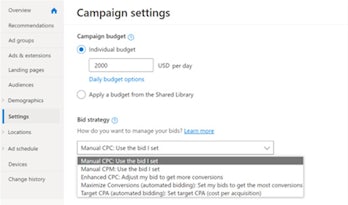Welcome to the latest blog from Impression on Paid Search Industry Updates, where we uncover the latest PPC trends to help you stay ahead of the curve.
With the long January finally over, we’ve started to see the wheels turn over in the world of PPC, with both some minor and major changes that paid media specialists should be aware of.
Google introduces account-level negative keyword lists

Whilst technically this news broke in January, it’s still more than relevant going into February and the months beyond that. Towards the end of January, Ads Liaison Ginny Marvin, announced on Twitter, that account-level negative keywords would be coming into the platform.
What does this mean for me?
You can access this new feature by heading to your account settings within the Google platform. From there, you will notice a new negative keyword tab.

The benefits of this move from Google mean, you can save time when creating your account negative keyword lists, before you’d have to apply them to each campaign, this allows you to apply a wide range of negatives that you don’t want to show for across all campaigns & google campaign types, instead of the old historical method of worrying if you’ve got certain negatives in different campaigns for example.
Additionally, it also means that you have greater control when it comes to where you’d like your ads to place, if there are terms which could be inappropriate or dangerous to your brand, you can exclude them in one go, across all campaign types, ensuring brand safety.
As usual with a negative keyword list, you are still restricted as normally to a maximum of 1,000 negative keyword lists & this will apply to; Search, Shopping & Performance Max campaigns.
In summary, it’s a good start from Google, allowing control from the account level, potentially saving yourself more time when it comes to a blanket negative keyword across all campaigns, it also hopefully will start the way for more control for advertisers, in where their ads place.
Exciting new Performance Max updates

On the 23rd of February Google announced in their latest blog several interesting new up & coming additions to Performance Max campaigns. The new changes are all centred around ways in which you can enhance your Performance Max results.
What does this mean for me?
The new changes, regardless of what we think of them, present a welcome addition. Performance Max wasn’t the finished product when it was launched, so we have to be prepared for new changes and additions along the way, as it adds new functionality to its offering.
The new updates from Google bring new features. Firstly, Google has finally announced that experiments are coming, this new feature will allow you to test Performance Max vs Standard Shopping, allowing you to see how results compare, giving you the best informed, data-led decision.
Furthermore, we are now also going to see campaign-level brand exclusions, this means for you that, you are starting to see more control over your campaign, and the exclusions mean that you can prevent yourself from appearing in branded queries in search and shopping inventory.
Another exciting new feature coming to the campaign is through page feeds, this will allow us to optimise results from your search inventory, and you will be able to create group URLs and use them for labels, allowing you to only show for particular products in a particular campaign or ad group, additionally, it means that you will be able to send traffic to a specific set of landing page URL’s on your site.
Lastly, another exciting feature, which we wanted to highlight, includes the new metrics coming to the asset group level. Google has stated that “soon”, we will be able to see; conversions, conversion value, cost and a variety of other metrics. The new metrics will further help us to optimise and will allow us to properly analyse our results, to see which asset groups are performing the best & which ones need to be optimised.
Google has provided a run down about the new features on their website.
Microsoft Advertising expands into 34 additional markets

Microsoft Advertising has expanded its global coverage by adding 34 new markets mostly located in Africa, reaching a total of 164 markets served worldwide and enabling marketers to reach over 1 billion people. The new markets include countries like Bermuda, Cameroon, and Tunisia. The full list of the 34 latest markets can be found here on the official Microsoft Advertising Blog.
What does this mean for me?
Expanding your marketing reach to new markets can be crucial for the growth and success of your business in several ways.
Firstly, it increases the potential customer base. Expanding to new markets allows you to reach a wider audience, increasing your chances of acquiring new customers and increasing your revenue.
Secondly, it diversifies your customer base. Depending on your business, having customers in various markets can help mitigate the risk of a decline in sales due to factors such as seasonality or economic fluctuations in one particular market.
Thirdly, it enhances brand recognition. By expanding to new markets, you can increase your brand awareness and recognition, establishing your business as a leader in your industry and helping to build your reputation.
Microsoft Advertising introduces the Enhanced CPC and the last-touch attribution model

Microsoft Advertising introduces the enhanced cost-per-click automated bidding strategy and the last-touch attribution model in all Microsoft Audience Network markets. This means that from February, new marketers will be able to use the popular bidding strategy, which the main aim is reducing the average cost per conversion and increasing the total number of conversions while maintaining the same campaign budgets.

In addition, Microsoft Advertising will offer the ability to modify our attribution for conversion goals to include both click-through and view-through conversions, potentially making Microsoft’s algorithm even more effective.
What does this mean for me?
The last-touch attribution model is an example of automated bidding strategies available on the Microsoft Audience Network. The model attributes all credit for a conversion to the last click or ad interaction that led to the conversion. This model assumes that the final touchpoint is the most important factor in a customer’s decision-making process and disregards the influence of any prior touchpoints.
The most important advantage of the model is that it is easy to understand and implement and can be a good starting point for businesses just getting started with attribution. However, more marketers should remember that the last-touch attribution model can overvalue certain channels, such as search or retargeting, and undervalue other channels that may have directly contributed to the customer’s decision to convert.
It’s worth mentioning that click-through and view-through conversions are important and relevant for every type of business because they provide valuable insights into the effectiveness of digital advertising campaigns, allowing marketers to optimise their ad spend and improve their return on ad spend (ROAS). See the two examples below.
Example 1: A company is running a paid search campaign and sees a high number of click-through conversions. In that case, it can infer that the ad copy resonates with the targeted audience and drives valuable traffic to its website. By optimising its bidding strategy and targeting based on these insights, the business can further improve campaign performance. This type of conversion can be beneficial for companies in industries where the typical purchase journey is more prolonged, such as buying a new luxury watch.
Example 2: A business is running a display remarketing campaign and sees a high number of view-through conversions. In that case, it can conclude that the prepared ads are increasing brand awareness and influencing purchase decisions even if users do not click on the ads. Marketers can further optimise campaign performance by testing different creative assets and message variations and still be able to monitor the results of their work.
Look out for our next blog in March for more paid search industry updates to inspire your PPC strategy. If you want to talk about your business’ aspirations, get in touch!



